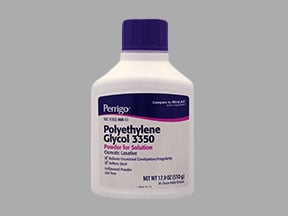
This medication is used to treat occasional constipation. It works by holding water in the stool to soften the stool and increases the number of bowel movements. It is known as an osmotic-type laxative. This medication is also available without a prescription. If you are taking this medication for self-treatment, it is important to read the manufacturer's package instructions carefully so you know when to consult your doctor or pharmacist.
My prescription
Edit
119GM of 17GM/SCOOP, Polyethylene Glycol 3350 (1 Bottle)
Select pharmacy

Walgreens
$6.22
COUPON PRICE
Albertsons
$6.43
COUPON PRICEFree Polyethylene Glycol 3350 Savings Card

Walgreens
$6.22
Show this coupon to your pharmacist
ID
LHB7643DBF
PCN
HT
BIN
011867
GRP
LABH001
This coupon is not insurance
This medication is used to treat occasional constipation. It works by holding water in the stool to soften the stool and increases the number of bowel movements. It is known as an osmotic-type laxative. This medication is also available without a prescription. If you are taking this medication for self-treatment, it is important to read the manufacturer's package instructions carefully so you know when to consult your doctor or pharmacist.
Our coupons are free to use. Before paying, show the pharmacist your Polyethylene Glycol 3350 savings card to get your free discount. Use our filters below to edit the prescription box to match your needs. The Polyethylene Glycol 3350 prices will update based on your prescription needs. Above our Polyethylene Glycol 3350 coupons, you can change your location to see pharmacy prices and costs in other areas. We're here to help you buy Polyethylene Glycol 3350 at the lowest price with our prescription discount card.
Our coupons are free to use. Before paying, show the pharmacist your Polyethylene Glycol 3350 savings card to get your free discount. Use our filters below to edit the prescription box to match your needs. The Polyethylene Glycol 3350 prices will update based on your prescription needs. Above our Polyethylene Glycol 3350 coupons, you can change your location to see pharmacy prices and costs in other areas. We're here to help you buy Polyethylene Glycol 3350 at the lowest price with our prescription discount card.
